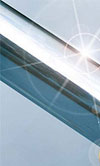Cavitation Shotless Peening
 Most people in the high performance world recoil when they hear a reference to cavitation. Cavitation, the formation of vapour bubbles in a flowing liquid, is usually the prelude to component failure, particularly
Most people in the high performance world recoil when they hear a reference to cavitation. Cavitation, the formation of vapour bubbles in a flowing liquid, is usually the prelude to component failure, particularly
with propellers, impellers, pumps, and all forms of hydraulic machinery. In some cases, even cylinder heads have been known to fail from this phenomenon. Cavitation occurs when the pressure of a liquid stream falls below its vapour pressure. As bubbles form and then collapse rapidly, intensely destructive shock waves can be produced
, and a great deal of effort goes into designing hydrodynamic devices so that cavitation is avoided.
Over the past few years however, a new surface treatment process that takes advantage of cavitation shock waves to produce beneficial surface compressive stress has been developed and refined. This technology is called Cavitation Shotless Peening (CSP). CSP provides the same benefits that conventional shot peening does: the surface of the material is work hardened and “closed up” so as to prevent destructive surface crack propagation. The difference is that, with CSP, the ‘peening’ is infinitely finer, resulting in a far smoother surface than with conventional shot peening. In fact, sometimes there is no visual evidence that the treatment has been applied!
Initial work on this methodology was done using a cavitating water jet on steel forging dies. The researchers found that varying upstream pressure, nozzle diameter, and nozzle distance from the work piece gave them complete control of the process, and applying the surface treatment created a 50% improvement in forging die life. The improvement to the surface of the forging dies was verified by an X-ray diffraction method, which allowed them to measure the compressive residual stress with great accuracy.
It should be emphasized here that CSP is not the same as ultrahigh-pressure water droplet peening; the surface modification is not accomplished by impact per se, but by the tiny local shock waves created from the collapsing bubbles in the fluid stream as it engages the work piece. As the shockwave impinges the surface of the material, it also creates a momentary, local, very high temperature condition, further improving the plasticity of the surface. Experiments have been performed with both the subject component and the jet stream fully submerged as well as with the component and jet stream set up to operate in open air. Work has also been done with cavitating oil jet streams in addition to water; in both cases, significant material strength improvements have been recorded. Tensile tests have shown up to a 50% improvement in yield strength with some aluminium alloys, and similar results have been reported with stainless steels, carbon steels, nonferrous metals, and titanium.
Test reports generally show surface hardness and material strength improvements at least as great as with conventional shot peening, but, at the same time, with a compressive layer that is usually thinner than the latter.
Some of the first dynamic components to be tested were impellers; it is ironic that Cavitation Shotless Peening was developed in part to prevent the destructive affects of …cavitation!
Written by John Stowe.